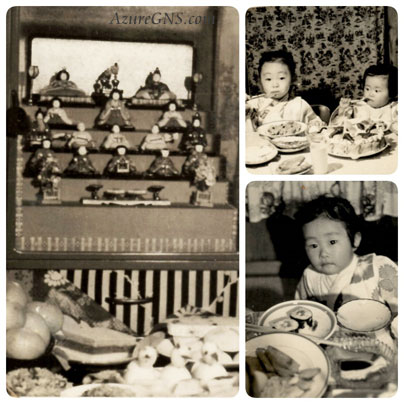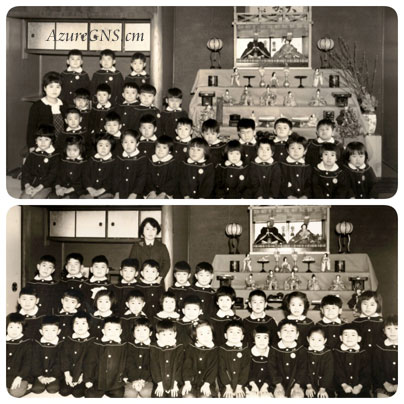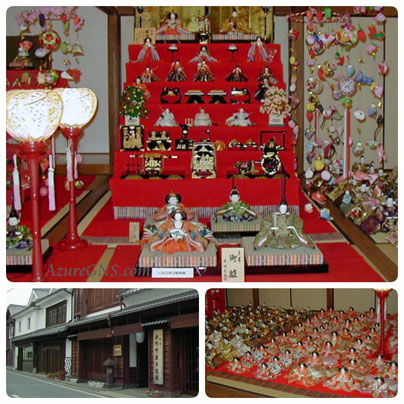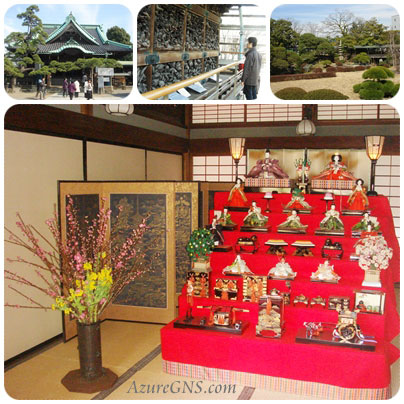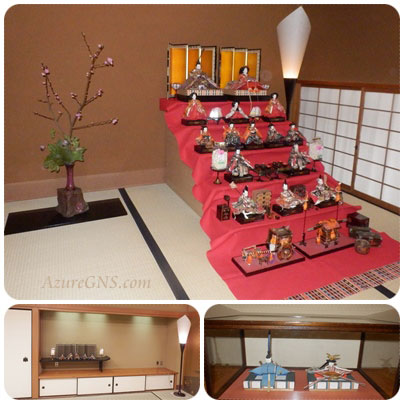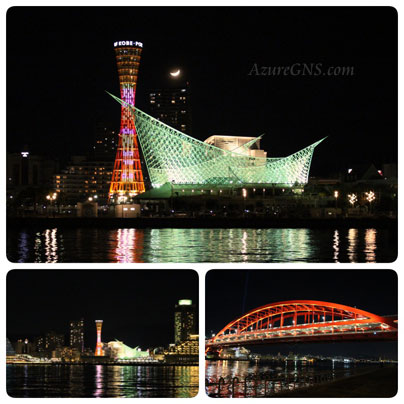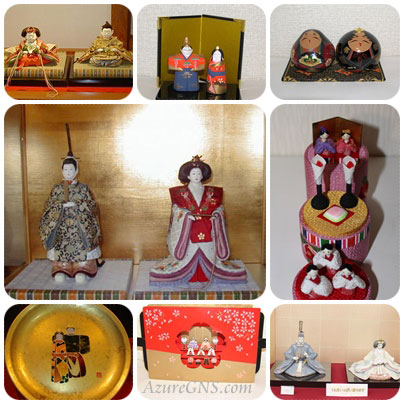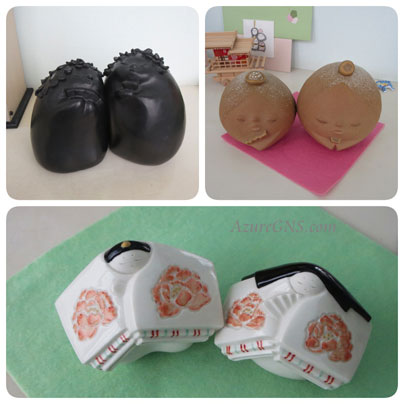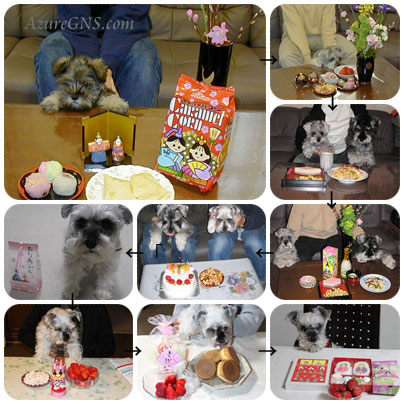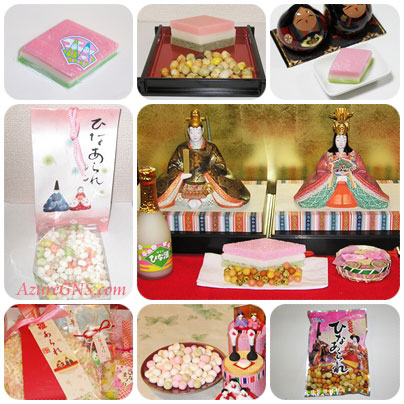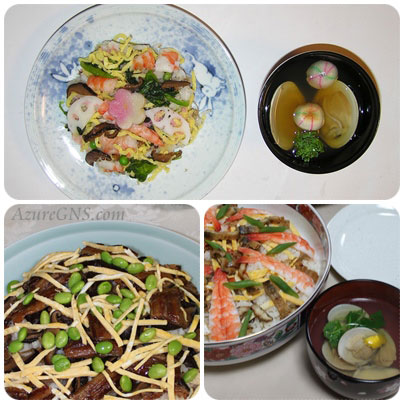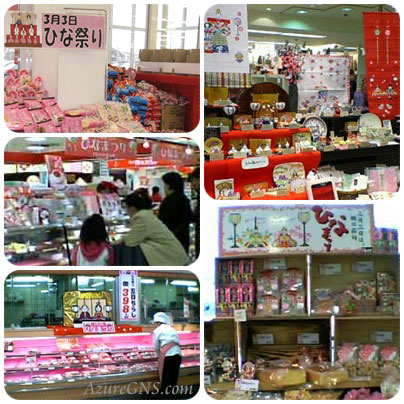Wagaya no Hina-matsuri;
Our Doll Festival Experience
姉と私の雛祭りには母がお赤飯(日本人がしばしばお祝いの際に食べる赤いごはん)を炊き、ご馳走をたくさん作ってお祝いをしてくれました。菱餅や雛あられも用意してくれました。古い写真を見ると、愛情いっぱいに育ててもらった幼き日々を思い出します。今は亡き両親に改めて心から感謝したいと思います。雛人形は骨董好きだった祖父が吟味して選んだ古美術品を贈ってくれました。当時まだ若かった母は何だか古くさい人形だと思い、その価値に全く興味がなかったそうです。雛祭り終わってすぐに雛人形を片付けないと、女の子が大きくなった時、なかなか結婚できなくなるという古い迷信があります。それにもかかわらず、母は雛人形を一年中出しっぱなしでしたが、姉も私も日本の平均的な年齢で結婚しました。
My mother made o-sekihan (red rice that Japanese people often eat at celebrations) and many dishes for my sister’s and my Hina-matsuri (a doll festival). She also bought hishi-mochi (diamond-shaped rice cakes) and hina-arare (sweetened puff rice). Old photos remind me of our young days full of our parents’ deep affection. I want to once again express my sincere gratitude to my late parents. Our set of Hina-ningyo (the dolls for the Doll Festival) was an antique from our grandfather, an antique lover who selected it especially for us. In those days, my mother was so young that she was not interested in its value but thought it was just an old set of dolls. There is an old superstition that if people display Hina-ningyo even just after Hina-matsuri is over, a girl will rarely get married when she grows up. In spite of that, my mother displayed Hina-ningyo all year round. However, my sister and I got married at the average age one marries in Japan.
私の通っていた幼稚園でも雛祭りが行われました。お雛様の歌を歌い、大きな雛人形の前で記念写真を撮ってもらいました。雛祭りということで、母は何を思ったか大きなリボンを私の頭に付けました。女の子らしさが微塵もない私には不似合いの大きさなリボンで、恥ずかしかったことを覚えています。
My kindergarten held Hina-matsuri annually. We sang a Hina-matsuri song and had a commemorative photo taken in front of a big set of Hina-ningyo. My mother put a big ribbon on my head for Hina-matsuri. I was embarrassed at an unsuitable ribbon for a tomboy without any girlish charm.
福岡県八女市本町の古くから「町屋」が並ぶ一角に、造り酒屋として栄えた高橋商店の工場だった建物が、ほぼそのままの姿で横町町家交流館として公開されています。人と文化の交流拠点で、八女ゆかりの芸術家達の作品が展示されています。私が訪問した時は、豪華な7段雛飾りと雛人形が飾られていました。内裏雛は伝統的な京都風に男雛が向かって右側、女雛が左側に飾られていました。それ以外に多くの雛人形が畳一面に並べられていました。「さげもん」と呼ばれる、縁起の良いお手製の人形をつるした雛飾りも展示されていました。
The factory of the once flourishing sake (rice wine) brewery still remains almost as it were and is open to the public as Yokomachi-machiya-koryukan (the Community Hall of the Traditional Merchant House in Yokomachi Town) on the street which is lined with traditional “machiya (merchants’ houses)” in Hommachi, Yame City, Fukuoka Prefecture. This house was renovated for the purpose of using it as an exhibition hall for works of artists associated with Yame City as well as a community hall. As I visited it around the Hinamatsuri season, a gorgeous seven-shelf Hina-kazari (a Hina decoration) was exhibited. A pair of Dairi-bina was displayed in traditional Kyoto style; Otoko-bina (the emperor) is on the right, and Onna-bina (the empress) is on the left from the viewer’s perspective. The floor of “tatami-mats (straw mats)” was covered with many Hina dolls. I also saw “Sagemon”, the hanging Hina-matsuri decorations consisting of auspicious handmade dolls.
東京都葛飾区の柴又帝釈天は創建1629年(寛永6年)の日蓮宗の寺院です。葛飾柴又といえば、多くの人が人情喜劇映画「男はつらいよ」を思い浮かべるでしょう。1969年(昭和44年)より1995年(平成7年)までの26年間、合計48作も続いた人気映画です。主人公の寅さんが、帝釈天の門前にある伯父の団子屋に戻って来て騒ぎを起こすのが、いつものパターンです。2008年(平成20年)2月末に帝釈天を訪問すると、大客殿前に広がる邃溪園(すいけいえん)に面するお部屋に立派な雛飾りがありました。京都とは反対に、関東風に男雛を向かって左側、女雛を右側に飾ってありました。
Shibamata Taishakuten in Katsushika Ward, Tokyo was established as a temple of the Nichiren sect of Buddhism in 1629 (Kanei 6th yr). Talking of Katsushika Shibamata, many people may recall a comedy film series which was full of humanity, “Otoko wa Tsuraiyo”. As many as 48 movies were released for 26 years from 1959 (Showa 44th yr) to 1995 (Heisei 7th yr). All these movies had the same basic plot: Tora-san, the main character went back to his uncle’s dumpling store on the approach of Taishakuten Temple and caused some trouble. In February 2008 (Heisei 20th yr), we visited Taishakuten Temple and saw a wonderful Hina-ningyo in the room which faced Suikei-en Garden in front of Dai-kyakuden (the great building of a temple or an aristocratic residence to entertain guests). Otoko-bina was on the left, and Onna-bina was on the right from the viewer’s perspective in a style of the Kanto District, the reverse way of Kyoto style.
2010年(平成22年)3月に家族と愛犬のふーちゃんとおーちゃんと一緒に、千葉県の佐原市へ旅行しました。古くから水郷の町として栄え、今もまだ江戸時代(1603-1867)の面影を残す街並みが残っています。当時の町人の暮らしに思いをはせながら、ゆっくり散策をしました。商店には雛人形が飾られていました。
In March 2010, I went to Sawara City, Chiba Prefecture with my family, Fuchan and Ohchan (my female and male Miniature Schnauzers). It was developed as a riverside port village long ago, and there are still some old streets and houses from the Edo period (1603-1867). We leisurely took a walk thinking about the people’s lives of those days and saw some sets of Hina-kazari decorated in the shops.
夫が幸運にも雛祭りの季節に、石川県金沢市の旅館、浅田屋さんに泊まる機会がありました。1867年(慶応3年)創業の金沢で最も有名な老舗旅館の一つです。旬の海の幸、山の幸を使った素晴らしい加賀料理と、心のこもったおもてなしを堪能したようです。格調漂う調度品の中でもひときわ目を引いたのが、雛人形だったようです。
My husband luckily had a chance to stay at Asada-ya in Kanazawa City during a Hina-matsuri season. This inn was one of the most famous and traditional inns in Kanazawa, established in 1867 (Keio 3rd yr). He enjoyed great meals of seasonal seafood and vegetables in the Kaga district and thoughtful hospitality. The Hina-ningyo displayed there especially attracted him among other refined decorations.
母が最期に入院していた兵庫県の芦屋市民病院にも、7段の素晴らしい雛人形が飾られていました。入院患者さんだけでなく、ご家族の皆様を癒やしてくれる可愛らしいお顔のお雛様でした。おそらくボランティアの皆様のお心遣いだったのでしょう。そのうえ、お茶を入れて下さったり、お部屋にお花を持って来て下さったりしました。短い間の入院でしたが、よくしていただいて感謝しています。雛祭りの季節になると、ふとこの雛人形を思い出します。
The wonderful Hina-ningyo on the 7 shelves was displayed in Ashiya City Hospital in Hyogo Prefecture, where we saw my mother’s last moment. Those dolls were pretty enough to heal both patients and their families. Probably volunteer staff displayed them for us. Moreover, they kindly served me tea and put a vase with flowers in my mother’s room. I appreciated them for their consideration though my mother was in the hospital for a few days. I sometimes remember the Hina-ningyo in this hospital during the Hina-matsuri season.
山口県柳井市の街並みふれあい館は、周防銀行本店として1907年(明治40年)に建築された当時はまだ珍しい洋風建築物です。2018年(平成30年)春に私が訪れた際には、たくさんの華やかな雛人形が、1階の資料館に並んでいました。人形は一見どれも同じような顔をしているようで、よく眺めてみますとそれぞれ個性豊かな風貌でした。2階は柳井市出身の昭和の大スター松島詩子さんの記念館になっていました。
Machinami Fureai-kan in Yanai City, Yamaguchi Prefecture used to be a head office of Suo Bank built in a western-style which was unusual in those days in 1907 (Meiji 40th yr). When I visited this building in spring, 2018 (Heisei30th yr), there were many gorgeous sets of Hina-ningyo in the reference library on the 1st floor. The faces of the dolls looked all similar at a glance; however, I found that they had individual features when I closely saw them. On the second floor, there was a memorial hall of Ms. Matsuhima Utako, a great star from this city in the Showa era (1926-1989).
私の実家は兵庫県神戸市中央区の高台の中腹にあり、窓からは元町や三宮の街並みを見渡すことができました。嫁ぐ日まで、自分の部屋から真正面に見える神戸港のポートタワーを毎日眺めていました。2010年(平成22年)から毎年雛祭りの時期に、ポートタワーはみやびな十二単(じゅうにひとえ)を模した、赤、黄、桃、緑に光るLEDライトが一斉に点灯します。2017年(平成29年)3月3日、対岸のポートアイランドからこの特別企画のポートタワーを見ました。神戸海洋博物館の帆船の帆と波をイメージした白い外観と、十二単のポートタワーが美しく輝いていました。
The house where I was raised was halfway up the hill in Chuo Ward, Kobe City, Hyogo Prefecture. I saw the towns of Motomachi and Sannomiya through the windows. I saw Kobe Port Tower right in front of my room until I left my home to get married. The Port Tower has been simultaneously lit up with red, yellow, pink and green LED lights modeled on graceful Juni-hitoe (layered kimono worn by a noble lady) around Hina-matsuri every year since 2010 (Heisei 22nd yr). I saw the Port Tower of this special version on the opposite port from Port Island on March 3rd, 2017 (Heisei 29th yr). The white appearance of the Kobe International Port Museum with the images of white waves and sails and the Port Tower of a Juni-hitoe version were shining beautifully in the dark.
かつて雛人形は豪華であればあるほど良く、七段飾りの雛壇が流行った時代もありました。しかし、昨今の住宅事情や伝統を簡素化する傾向のため、内裏雛だけの雛人形を求める人が増えています。最もよく見られるのは座った状態の「座り雛」です。また、立った状態のお雛様は「立ち雛」と呼ばれます。これは簡素化されたお雛様と思われがちですが、実は雛人形の原型と言われた「紙雛」に近い形と言われています。「紙雛」とは、息を吹きかけて川や海に流して厄払いをした紙で作った人形(ひとがた)です。
People once regarded Hina-ningyo as the more gorgeous and more valuable; therefore, Hina-ningyo on the 7-tiered stands were popular. However, today, people tend to like Hina-ningyo which is only a pair of Dairi-bina (the Emperor and Empress) because of the lack of space in the homes and simplification of tradition. The most popular Hina-ningyo is “Suwari-bina”, sitting Hina-ningyo. Standing Hina-ningyo is called “Tachi-bina” which tends to be considered as a simplified set of Hina-doll but actually it is close to the origin of Hina-ningyo, “Kami-bina”. It is a piece of paper shaped like the figure of a man and people breathe on it and float it on the river or the sea for driving away evil spirits.
友人のお宅を訪問して楽しいおしゃべりと昼食を楽しんだ後、おいとまする際に吸い寄せられるように目に泊まったのは、お玄関に飾られた創造的な雛人形でした。作家さんの芸術作品と思われ、芸術的才能が豊かな彼女らしいコレクションです。ウェブサイトに掲載したいので写真を撮らして欲しいとお願いしたら、快く承諾して下さいました。
When I was leaving my friend’s house after enjoying chatting and lunch, my eyes were drawn to several unique sets of Hina-ningyo in the entrance hall. They are supposed to be made by artists and lovely collections just like my friend who was richly gifted in art. She pleasantly accepted my request to let me take some pictures of these dolls for my website.
私には娘はいませんが、その代わりふーちゃん(ミニチュア・シュナウザーの女の子)の健やかな成長を祈り、毎年雛祭りのお祝いをしました。当然、彼女は雛祭りが何かは全く理解していませんが、お菓子や果物に興味津々でした。夫はふーちゃんのために可愛い雛人形を買ってきました。しかし、悲しいことに2014年(平成26年)に12歳で天国の虹の橋のたもとへ行ってしまいました。その後、すーちゃんとうーちゃんという女の子のミニチュア・シュナウザーを家族に迎え、雛祭りが再び華やぎました。
I don’t have any daughters; instead, I celebrated Hina-matsuri for Fuchan (a female Miniature Schnauzer) to pray for her healthy growth every year. Naturally, she didn’t understand what Hina-matsuri was, but she was very much interested in the sweets and fruits. My husband bought cute Hina-ningyo for Fuchan. However, to our sorrow, she went over to the foot of the Rainbow Bridge of Heaven at the age of 12. A few years later, two young girl Miniature Schnauzers joined our family and they made Hina-matsuri brightened again.
菱餅と雛あられは雛祭りに欠かせないお菓子です。菱餅はその名の通り、菱形に切った3色の餅を重ねたものです。地方によっては2色、5色、7色などもあります。雛あられも様々な味、形状、色がありますが、大きく分けると2種類です。関東でよく食べられるのは、米を熱して爆発させて膨らませる、いわゆるポン菓子に砂糖蜜をかけて食用染料で着色したものです。関西では、蒸した糯米(もちごめ)を十分に乾燥させたものを煎り、砂糖蜜を絡めたカリカリしたあられがよく食べられます。それ以外に、醤油味、塩味、海老味、青海苔味などがあり、豆菓子が加えられることもあります。日本で初めて雛あられにチョコレートをコーティングしたのは、米菓子メーカーのとよす株式会社です。
Hishi-mochi (a diamond-shaped rice cake) and hina-arare (sweetened puffed rice or small round rice crackers) are symbolic sweets for Hina-matsuri. Hishi-mochi is a rice cake which commonly consists of three layers of three different colors. There are also some other variations: 2, 5 or 7 different colors depending on regions. Hina-arare also has some variations of tastes, shapes and colors and there are two major styles. People in the Kanto area are more familiar with pon-gashi, puffed rice coated with syrup and dyed with edible pigments. Hina-arare of the Kansai style is roasted crunchy glutinous rice, which is dried enough after being steamed, and coated with syrup. Besides that, hina-arare comes with some other flavors; soy sauce, salt, shrimp and green laver, and sweets made of beans are sometimes added. Hina-arare coated with chocolate was first invented by Toyosu Co., Ltd., a manufacturer of sweets and snacks made from rice.
菱餅や雛あられ以外にも、この時期しか楽しめない多種多様な雛祭りのお菓子が販売されています。お煎餅、砂糖菓子、お饅頭、子供用ノンアルコールの白酒などを購入しました。ほとんどの雛祭りのお菓子は桃色、白色、緑色が基本色です。どのお菓子も可愛らしく、箱、袋、包装紙も雛祭りらしい趣向が凝らされ、舌でも目でも楽しむこともできます。
Besides Hishi-mochi and Hina-arare, many kinds of special Hina-gashi (sweets for the Doll Festival) are on sale in the Hina-matsuri season. We bought rice crackers, candy, manju (a Japanese-style bun stuffed with anko, sweeten adzuki-bean paste) and nonalcoholic shiro-zake (white sake containing rice malt) for children. Hina-gashi (sweets for the Doll Festival) are basically pink, white and green. Both sweets and wrapping items such as boxes, bags and papers are so pretty and elaborate that we can enjoy them with our tongues and eyes.
石川県金沢市や富山県西部の雛祭りには金花糖(きんかとう)という砂糖菓子が欠かせません。婚礼の引き出物として用意されることもあります。金花糖とは江戸時代に日本に伝わった南蛮菓子の有平糖(あるへいとう)を模倣したものです。煮溶かした白砂糖を桜などの木型に流し込み、冷やし固め、食用色素で彩色します。鯛、野菜、果物、雛人形、招き猫、七福神などの形をした目で楽しむお菓子になります。
Candy called kinkato is essential for Hina-matsuri in Kanazawa City, Ishikawa Prefecture and the western part of Toyama Prefecture. Kinkato is also sometimes given to guests at wedding receptions. Kiinkato was created in imitation of aruheito, a kind of sweets which was introduced into Japan from Europe in the Edo period (1603-1868). How to make kinkato is the following: melted sugar is cast into the mold made of cherry wood, cooled until it hardens and dyed with edible pigments. Kinkato is usually in the shape of sea breams, vegetables, fruits, Hina-dolls, Maneki-neko (beckoning cats) and Shichi-fuku-jin (the seven lucky gods). This candy is for decoration rather than for eating.
伝統を繋ぎつつも新しい時代の流れを取り入れながら、雛祭りは祝われています。最近は菱餅よりも雛祭りケーキの方が子供達に人気があります。定番のものは、お雛様とお内裏様の砂糖菓子やぼんぼり型のろうそくが、生クリームたっぷりの円形のスポンジケーキに載っています。菱餅のような菱形のケーキもあります。雛祭りケーキには、甘い香りだけで皆を笑顔にする魔法の力があると思います。
Hina-matsuri has been celebrated, respecting tradition and also keeping up with the times. These days, children prefer a Hina-matsuri cake to a hishi-mochi rice cake. The most popular Hina-matsuri cake is a round sponge cake covered with whipped cream and decorated with candy dolls of a pair of Dairi-bina (the Emperor and the Empress) on the top. We can also buy a Hina-matsuri cake in the shape of a diamond like hishi-mochi. A Hina-matsuri cake has a magical power to make people smile only with its sweet smell.
雛祭りの代表的なお料理といえばちらし寿司と蛤のお吸い物です。ちらし寿司の材料や作り方は、地方、家庭、世代によってさまざまです。我が家のちらし寿司はたいてい具だくさんです。私は特に穴子、海老、錦糸玉子が大好きなのでたっぷり載せます。蛤を雛祭りに食べるのは、かつて二枚貝が女性の貞操の象徴と考えられていたからです。何だか古い女性差別的な発想だなと、若干抵抗は感じますが伝統と割り切って、蛤のお吸い物も作ります。
A typical Hina-matsuri feast includes chirashi-zushi (sushi rice mixed and topped with vegetables and seafood) and Hamaguri-no-osuimono (clear clam soup). Ingredients and the method of cooking chirashi-zushi vary according to regions, families and generations. We usually make chirashi-zushi with a lot of ingredients and we especially like grilled or steamed anago (conger eels), boiled shrimp and kinshi-tamago (Japanese style thinly sliced omelet) on top. The reason why we eat Hamaguri clams for Hina-matsuri originated from an old-fashioned and a kind of discrimination against women: people once regarded a bivalve mollusk, such as a clam, as a symbol of a woman’s chastity. I don’t agree with this idea, but I make Hamaguri-no-osuimono every year because it has become just one dish for a traditional dinner these days.
雛祭りが近付くとデパートやスーパーでは雛祭りコーナーが設けられます。様々な可愛い雛人形や雛祭りの飾りが並びます。雛祭り食品コーナーでは白酒、菱餅、雛あられ、他の雛菓子、ちらし寿司の材料などが売られています。雛祭り当日は、ケーキや、出来合いのちらし寿司を買う人々で賑わいます。私も生徒さんやスタッフの皆のための買い物を毎年楽しみます。
When Hina-matsuri is drawing near, Hina-matsuri corners open in department stores and supermarkets. Various pretty Hina-ningyo and Hina-matsuri decorations start to be sold. In Hina-matsuri food corners, there are shiro-zake, hishi-mochi, hina-arare, other hina-gashi and ingredients for chirashi-zushi. On Hina-matsuri days, stores are crowded with customers who are buying cakes and ready-made chirashi-zushi. I also enjoy shopping for students and employees every year.
(「雛祭り」へ戻る)
(Back to “The Doll Festival“)
Copyright (C) Azure Global Network Services. All Rights Reserved.
